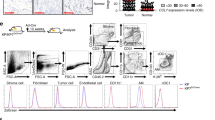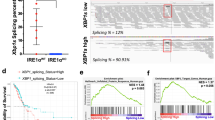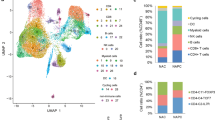Abstract
Immunotherapeutic approaches, particularly programmed death 1/programmed death ligand 1 (PD-1/PD-L1) blockade, have improved the treatment of non-small-cell lung cancer (NSCLC), supporting the premise that evasion of immune destruction is of importance for NSCLC progression. However, the signals responsible for upregulation of PD-L1 in NSCLC cells and whether they are integrated with the regulation of other immune-related genes are not known. Mucin 1 (MUC1) is aberrantly overexpressed in NSCLC, activates the nuclear factor-κB (NF-κB) p65→ZEB1 pathway and confers a poor prognosis. The present studies demonstrate that MUC1-C activates PD-L1 expression in NSCLC cells. We show that MUC1-C increases NF-κB p65 occupancy on the CD274/PD-L1 promoter and thereby drives CD274 transcription. Moreover, we demonstrate that MUC1-C-induced activation of NF-κB→ZEB1 signaling represses the TLR9 (toll-like receptor 9), IFNG, MCP-1 (monocyte chemoattractant protein-1) and GM-CSF genes, and that this signature is associated with decreases in overall survival. In concert with these results, targeting MUC1-C in NSCLC tumors suppresses PD-L1 and induces these effectors of innate and adaptive immunity. These findings support a previously unrecognized central role for MUC1-C in integrating PD-L1 activation with suppression of immune effectors and poor clinical outcome.
This is a preview of subscription content, access via your institution
Access options
Subscribe to this journal
Receive 50 print issues and online access
$259.00 per year
only $5.18 per issue
Buy this article
- Purchase on Springer Link
- Instant access to full article PDF
Prices may be subject to local taxes which are calculated during checkout







Similar content being viewed by others
Accession codes
Abbreviations
- NSCLC:
-
non-small cell lung cancer
- EGFR:
-
epidermal growth factor receptor
- PD-1:
-
programmed death 1
- PD-L1:
-
programmed death ligand 1
- MUC1:
-
mucin 1
- MUC1-C:
-
MUC1 C-terminal subunit
- CD274 :
-
gene encoding PD-L1
- GEMMs:
-
genetically engineered mouse models
- DOX:
-
doxycycline
- ChIP:
-
chromatin immunoprecipitation
- TLR7:
-
toll-like receptor 7
- TLR9:
-
toll-like receptor 9
- IFN-γ:
-
interferon-gamma
- MCP-1:
-
monocyte chemoattractant protein-1
- GM-CSF:
-
granulocyte-monocyte colony-stimulating factor.
References
Hanahan D, Weinberg RA . Hallmarks of cancer: the next generation. Cell 2011; 144: 646–674.
Balkwill F, Charles KA, Mantovani A . Smoldering and polarized inflammation in the initiation and promotion of malignant disease. Cancer Cell 2005; 7: 211–217.
Carrizosa DR, Gold KA . New strategies in immunotherapy for non-small cell lung cancer. Transl Lung Cancer Res 2015; 4: 553–559.
Reck M, Paz-Ares L . Immunologic checkpoint blockade in lung cancer. Semin Oncol 2015; 42: 402–417.
Mayor M, Yang N, Sterman D, Jones DR, Adusumilli PS . Immunotherapy for non-small cell lung cancer: current concepts and clinical trials. Eur J Cardiothorac Surg 2015; 49: 1324–1333.
Akbay EA, Koyama S, Carretero J, Altabef A, Tchaicha JH, Christensen CL et al. Activation of the PD-1 pathway contributes to immune escape in EGFR-driven lung tumors. Cancer Discov 2013; 3: 1355–1363.
Koyama S, Akbay EA, Li YY, Aref AR, Skoulidis F, Herter-Sprie GS et al. STK11/LKB1 deficiency promotes neutrophil recruitment and proinflammatory cytokine production to suppress T cell activity in the lung tumor microenvironment. Cancer Res 2016; 76: 999–1008.
Situ D, Wang J, Ma Y, Zhu Z, Hu Y, Long H et al. Expression and prognostic relevance of MUC1 in stage IB non-small cell lung cancer. Med Oncol 2010; 28: 596–604.
Jarrard JA, Linnoila RI, Lee H, Steinberg SM, Witschi H, Szabo E . MUC1 is a novel marker for the type II pneumocyte lineage during lung carcinogenesis. Cancer Res 1998; 58: 5582–5589.
Awaya H, Takeshima Y, Yamasaki M, Inai K . Expression of MUC1, MUC2, MUC5AC, and MUC6 in atypical adenomatous hyperplasia, bronchioloalveolar carcinoma, adenocarcinoma with mixed subtypes, and mucinous bronchioloalveolar carcinoma of the lung. Am J Clin Pathol 2004; 121: 644–653.
Khodarev N, Pitroda S, Beckett M, MacDermed D, Huang L, Kufe D et al. MUC1-induced transcriptional programs associated with tumorigenesis predict outcome in breast and lung cancer. Cancer Res 2009; 69: 2833–2837.
MacDermed DM, Khodarev NN, Pitroda SP, Edwards DC, Pelizzari CA, Huang L et al. MUC1-associated proliferation signature predicts outcomes in lung adenocarcinoma patients. BMC Med Genomics 2010; 3: 16.
Xu F, Liu F, Zhao H, An G, Feng G . Prognostic significance of mucin antigen MUC1 in various human epithelial cancers: a meta-analysis. Medicine (Baltimore) 2015; 94: e2286.
Imielinski M, Berger AH, Hammerman PS, Hernandez P, Pugh TJ, Hodis E et al. Mapping the hallmarks of lung adenocarcinoma with massively parallel sequencing. Cell 2012; 150: 1107–1120.
Cancer Genome Atlas Research N. Comprehensive genomic characterization of squamous cell lung cancers. Nature 2012; 489: 519–525.
Cancer Genome Atlas Research N.. Comprehensive molecular profiling of lung adenocarcinoma. Nature 2014; 511: 543–550.
Kufe D . Mucins in cancer: function, prognosis and therapy. Nat Rev Cancer 2009; 9: 874–885.
Kufe D . MUC1-C oncoprotein as a target in breast cancer: activation of signaling pathways and therapeutic approaches. Oncogene 2013; 32: 1073–1081.
Ramasamy S, Duraisamy S, Barbashov S, Kawano T, Kharbanda S, Kufe D . The MUC1 and galectin-3 oncoproteins function in a microRNA-dependent regulatory loop. Mol Cell 2007; 27: 992–1004.
Raina D, Agarwal P, Lee J, Bharti A, McKnight C, Sharma P et al. Characterization of the MUC1-C cytoplasmic domain as a cancer target. PLoS One 2015; 10: e0135156.
Ahmad R, Raina D, Trivedi V, Ren J, Rajabi H, Kharbanda S et al. MUC1 oncoprotein activates the IκB kinase β complex and constitutive NF-κB signaling. Nat Cell Biol 2007; 9: 1419–1427.
Ahmad R, Raina D, Joshi MD, Kawano T, Kharbanda S, Kufe D . MUC1-C oncoprotein functions as a direct activator of the NF-κB p65 transcription factor. Cancer Res 2009; 69: 7013–7021.
Takahashi H, Jin C, Rajabi H, Pitroda S, Alam M, Ahmad R et al. MUC1-C activates the TAK1 inflammatory pathway in colon cancer. Oncogene 2015; 34: 5187–5197.
Leng Y, Cao C, Ren J, Huang L, Chen D, Ito M et al. Nuclear import of the MUC1-C oncoprotein is mediated by nucleoporin Nup62. J Biol Chem 2007; 282: 19321–19330.
Raina D, Ahmad R, Rajabi H, Panchamoorthy G, Kharbanda S, Kufe D . Targeting cysteine-mediated dimerization of the MUC1-C oncoprotein in human cancer cells. Int J Oncol 2012; 40: 1643–1649.
Raina D, Kosugi M, Ahmad R, Panchamoorthy G, Rajabi H, Alam M et al. Dependence on the MUC1-C oncoprotein in non-small cell lung cancer cells. Mol Cancer Ther 2011; 10: 806–816.
Kharbanda A, Rajabi H, Jin C, Tchaicha J, Kikuchi E, Wong K et al. Targeting the oncogenic MUC1-C protein inhibits mutant EGFR-mediated signaling and survival in non-small cell lung cancer cells. Clin Cancer Res 2014; 20: 5423–5434.
Kharbanda A, Rajabi H, Jin C, Alam M, Wong K, Kufe D . MUC1-C confers EMT and KRAS independence in mutant KRAS lung cancer cells. Oncotarget 2014; 5: 8893–8905.
Kufe D . Functional targeting of the MUC1 oncogene in human cancers. Cancer Biol Ther 2009; 8: 1201–1207.
Hasegawa M, Sinha RK, Kumar M, Alam M, Yin L, Raina D et al. Intracellular targeting of the oncogenic MUC1-C protein with a novel GO-203 nanoparticle formulation. Clin Cancer Res 2015; 21: 2338–2347.
Sunaga N, Imai H, Shimizu K, Shames DS, Kakegawa S, Girard L et al. Oncogenic KRAS-induced interleukin-8 overexpression promotes cell growth and migration and contributes to aggressive phenotypes of non-small cell lung cancer. Int J Cancer 2012; 130: 1733–1744.
Cherfils-Vicini J, Platonova S, Gillard M, Laurans L, Validire P, Caliandro R et al. Triggering of TLR7 and TLR8 expressed by human lung cancer cells induces cell survival and chemoresistance. J Clin Invest 2010; 120: 1285–1297.
Chatterjee S, Crozet L, Damotte D, Iribarren K, Schramm C, Alifano M et al. TLR7 promotes tumor progression, chemotherapy resistance, and poor clinical outcomes in non-small cell lung cancer. Cancer Res 2014; 74: 5008–5018.
Dajon M, Iribarren K, Cremer I . Dual roles of TLR7 in the lung cancer microenvironment. Oncoimmunology 2015; 4: e991615.
Lee J, Hayashi M, Lo JF, Fearns C, Chu WM, Luo Y et al. Nuclear factor kappaB (NF-kappaB) activation primes cells to a pro-inflammatory polarized response to a Toll-like receptor 7 (TLR7) agonist. Biochem J 2009; 421: 301–310.
Rajabi H, Alam M, Takahashi H, Kharbanda A, Guha M, Ahmad R et al. MUC1-C oncoprotein activates the ZEB1/miR-200c regulatory loop and epithelial-mesenchymal transition. Oncogene 2014; 33: 1680–1689.
Takeshita F, Suzuki K, Sasaki S, Ishii N, Klinman DM, Ishii KJ . Transcriptional regulation of the human TLR9 gene. J Immunol 2004; 173: 2552–2561.
Lee SJ, Jang BC, Lee SW, Yang YI, Suh SI, Park YM et al. Interferon regulatory factor-1 is prerequisite to the constitutive expression and IFN-gamma-induced upregulation of B7-H1 (CD274). FEBS Lett 2006; 580: 755–762.
Harada H, Fujita T, Miyamoto M, Kimura Y, Maruyama M, Furia A et al. Structurally similar but functionally distinct factors, IRF-1 and IRF-2, bind to the same regulatory elements of IFN and IFN-inducible genes. Cell 1989; 58: 729–739.
Deshmane SL, Kremlev S, Amini S, Sawaya BE . Monocyte chemoattractant protein-1 (MCP-1): an overview. J Interferon Cytokine Res 2009; 29: 313–326.
Chen L, Gibbons DL, Goswami S, Cortez MA, Ahn YH, Byers LA et al. Metastasis is regulated via microRNA-200/ZEB1 axis control of tumour cell PD-L1 expression and intratumoral immunosuppression. Nat Commun 2014; 5: 5241.
Metcalf D . The colony-stimulating factors and cancer. Nat Rev Cancer 2010; 10: 425–434.
Hou J, Aerts J, den Hamer B, van Ijcken W, den Bakker M, Riegman P et al. Gene expression-based classification of non-small cell lung carcinomas and survival prediction. PLoS One 2010; 5: e10312.
Xie Y, Xiao G, Coombes KR, Behrens C, Solis LM, Raso G et al. Robust gene expression signature from formalin-fixed paraffin-embedded samples predicts prognosis of non-small-cell lung cancer patients. Clin Cancer Res 2011; 17: 5705–5714.
Huang G, Wen Q, Zhao Y, Gao Q, Bai Y . NF-kappaB plays a key role in inducing CD274 expression in human monocytes after lipopolysaccharide treatment. PLoS One 2013; 8: e61602.
Gowrishankar K, Gunatilake D, Gallagher SJ, Tiffen J, Rizos H, Hersey P . Inducible but not constitutive expression of PD-L1 in human melanoma cells is dependent on activation of NF-kappaB. PLoS One 2015; 10: e0123410.
Bouillez A, Rajabi H, Pitroda S, Jin C, Alam M, Kharbanda A et al. Inhibition of MUC1-C suppresses MYC expression and attenuates malignant growth in KRAS mutant lung adenocarcinomas. Cancer Res 2016; 76: 1538–1548.
Casey SC, Tong L, Li Y, Do R, Walz S, Fitzgerald KN et al. MYC regulates the antitumor immune response through CD47 and PD-L1. Science 2016; 352: 227–231.
Hemmi H, Takeuchi O, Kawai T, Kaisho T, Sato S, Sanjo H et al. A Toll-like receptor recognizes bacterial DNA. Nature 2000; 408: 740–745.
Takeshita F, Leifer CA, Gursel I, Ishii KJ, Takeshita S, Gursel M et al. Cutting edge: Role of Toll-like receptor 9 in CpG DNA-induced activation of human cells. J Immunol 2001; 167: 3555–3558.
Pivarcsi A, Muller A, Hippe A, Rieker J, van Lierop A, Steinhoff M et al. Tumor immune escape by the loss of homeostatic chemokine expression. Proc Natl Acad Sci USA 2007; 104: 19055–19060.
Ronkainen H, Hirvikoski P, Kauppila S, Vuopala KS, Paavonen TK, Selander KS et al. Absent Toll-like receptor-9 expression predicts poor prognosis in renal cell carcinoma. J Exp Clin Cancer Res 2011; 30: 84.
Sandholm J, Selander KS . Toll-like receptor 9 in breast cancer. Front Immunol 2014; 5: 330.
Akira S, Takeda K, Kaisho T . Toll-like receptors: critical proteins linking innate and acquired immunity. Nat Immunol 2001; 2: 675–680.
Schroder K, Hertzog PJ, Ravasi T, Hume DA . Interferon-gamma: an overview of signals, mechanisms and functions. J Leukoc Biol 2004; 75: 163–189.
Seliger B, Ruiz-Cabello F, Garrido F . IFN inducibility of major histocompatibility antigens in tumors. Adv Cancer Res 2008; 101: 249–276.
Agnello D, Lankford CS, Bream J, Morinobu A, Gadina M, O'Shea JJ et al. Cytokines and transcription factors that regulate T helper cell differentiation: new players and new insights. J Clin Immunol 2003; 23: 147–161.
Hu X, Chakravarty SD, Ivashkiv LB . Regulation of interferon and Toll-like receptor signaling during macrophage activation by opposing feedforward and feedback inhibition mechanisms. Immunol Rev 2008; 226: 41–56.
Mak MP, Tong P, Diao L, Cardnell RJ, Gibbons DL, William WN et al. A patient-derived, pan-cancer EMT signature identifies global molecular alterations and immune target enrichment following epithelial-to-mesenchymal transition. Clin Cancer Res 2016; 22: 609–620.
Lou Y, Diao L, Parra Cuentas ER, Denning WL, Chen L, Fan YH et al. Epithelial-mesenchymal transition is associated with a distinct tumor microenvironment including elevation of inflammatory signals and multiple immune checkpoints in lung adenocarcinoma. Clin Cancer Res 2016; 31: 245–258.
Gnemmi V, Bouillez A, Gaudelot K, Hemon B, Ringot B, Pottier N et al. MUC1 drives epithelial–mesenchymal transition in renal carcinoma through Wnt/beta-catenin pathway and interaction with SNAIL promoter. Cancer Lett 2014; 346: 225–236.
Tagde A, Rajabi H, Bouillez A, Alam M, Gali R, Bailey S et al. MUC1-C drives MYC in multiple myeloma. Blood 2016; 127: 2587–2597.
Welsh EA, Eschrich SA, Berglund AE, Fenstermacher DA . Iterative rank-order normalization of gene expression microarray data. BMC Bioinform 2013; 14: 153.
Samur MK . RTCGAToolbox: a new tool for exporting TCGA Firehose data. PLoS One 2014; 9: e106397.
Gyorffy B, Surowiak P, Budczies J, Lanczky A . Online survival analysis software to assess the prognostic value of biomarkers using transcriptomic data in non-small-cell lung cancer. PLoS One 2013; 8: e82241.
Goodwin JM, Svensson RU, Lou HJ, Winslow MM, Turk BE, Shaw RJ . An AMPK-independent signaling pathway downstream of the LKB1 tumor suppressor controls Snail1 and metastatic potential. Mol Cell 2014; 55: 436–450.
Acknowledgements
Research reported in this publication was supported by the National Cancer Institute of the National Institutes of Health under award numbers CA97098 and CA166480, and by the Lung Cancer Research Foundation.
Author contributions
AB, HR, K-KW, SK and DK designed the research; AB, HR, CJ, MA, MH, TM, XH and DA performed the research and data analysis; MS and AT performed bioinformatics analysis; AB, K-KW and DK wrote the manuscript.
Author information
Authors and Affiliations
Corresponding author
Ethics declarations
Competing interests
DK holds equity in Genus Oncology and is a consultant to the company. The authors declare no conflict of interest.
Additional information
Supplementary Information accompanies this paper on the Oncogene website
Rights and permissions
About this article
Cite this article
Bouillez, A., Rajabi, H., Jin, C. et al. MUC1-C integrates PD-L1 induction with repression of immune effectors in non-small-cell lung cancer. Oncogene 36, 4037–4046 (2017). https://doi.org/10.1038/onc.2017.47
Received:
Revised:
Accepted:
Published:
Issue Date:
DOI: https://doi.org/10.1038/onc.2017.47
This article is cited by
-
Epithelial-to-mesenchymal transition in cancer progression: unraveling the immunosuppressive module driving therapy resistance
Cancer and Metastasis Reviews (2024)
-
Targeting the NF-κB pathway as a potential regulator of immune checkpoints in cancer immunotherapy
Cellular and Molecular Life Sciences (2024)
-
Mechanisms driving the immunoregulatory function of cancer cells
Nature Reviews Cancer (2023)
-
MUC1 promotes lung metastases of liver cancer by impairing anti-tumor immunity
Discover Oncology (2023)
-
The modulation of PD-L1 induced by the oncogenic HBXIP for breast cancer growth
Acta Pharmacologica Sinica (2022)



